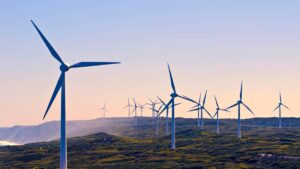Hydrogen is pulling away from the starting line, but it has a long way to catch up

A hydrogen car refuels at a filling station. Pic: Getty
Hydrogen fuel cell vehicles could have their day in the Australian sun with energy infrastructure company Jemena reaching a deal with Hyundai Australia and Coregas to produce ‘green’ hydrogen.
The memorandum of understanding will see Jemena, an $11.5bn company that owns and manages some of Australia’s most significant gas and electricity assets, use solar and wind power to produce and deliver hydrogen gas to Hyundai’s Macquarie Park headquarters in Sydney from early 2021.
Jemena managing director Frank Tudor says the deal is an opportunity to demonstrate that renewably generated hydrogen gas can be made directly available to the vehicle and transport sectors.
The hydrogen gas for transport will be generated as part of Jemena’s $15m Western Sydney Green Gas project, which is being co-funded on a 50 per cent basis by the Australian Renewable Energy Agency.
Besides producing gas for the hydrogen vehicle industry, the project will also test how hydrogen can be stored and used across Jemena’s New South Wales gas network.
“We are demonstrating that electrolysers not only produce safe and green hydrogen gas to blend with natural gas for home appliances, but that they also enable hydrogen to be made available for zero-emission transportation,” Tudor added.
Hydrogen playing catch up with plug-in competitors
However, hydrogen fuel cell electric vehicles (FCEV) are playing catch up with plug-in battery electric vehicles (BEV).
There are currently less than a dozen production FCEV models available for sale while total sales have yet to crack the 10,000 vehicle mark globally in 2019.
In comparison, Tesla alone delivered about 367,500 vehicles in 2019, a significant chunk of the 2.2 million BEVs sold in 2020, according to S&P Global Market Intelligence.
This is despite FCEVs, which combine hydrogen and oxygen to produce electricity that in turn runs the motor, having ranges of about 650km – well above the sub-200km ranges that most mass market BEVs are capable of.
FCEVs also benefit from fast refuelling. Like regular internal combustion engine vehicles, FCEVs take just five to 10 minutes to top up their fuel tanks while even Tesla’s fast chargers take 30 minutes to reach an 80 per cent charge.
So just what is holding FCEVs back?
Infrastructure challenges for hydrogen vehicles
The Hydrogen Council estimated that in 2018 there were over 330 hydrogen refuelling stations around the world, half of which were in Japan and the US.
Australia has one official refuelling station at Hyundai’s Macquarie Park showroom, which makes it a little hard for someone in Perth to refuel to put it mildly.
This situation might improve somewhat with a refuelling station currently under construction in the ACT, with others planned for Melbourne and Brisbane.
In contrast, the International Energy Agency estimated there were about 7.3 million battery chargers worldwide in 2019, about 6.5 million of which were private, light-duty vehicle slow chargers in homes.
And that number is expected to grow with even BP announcing it will have up to 70,000 electric vehicle charging points from the current 7,500.
Part of this is due to the need to extract hydrogen from water using electrolysis, which requires power, and compressing it to a reasonable volume. Getting the resulting fuel into your car also requires its own set of machinery and automated controls.
This means that it is pretty unlikely at this stage to be able to charge a FCEV at home the same way one can do with a BEV.
Despite this, there is still considerable appetite for the development of a hydrogen economy in Australia as it is a potential export good that could take the place of natural gas and coal.
South Korea has also rolled out a road map for a transition to a hydrogen economy in a bid to reduce its dependence on imported oil.
The IEA has also suggested the use of clean hydrogen to power high-mileage cars, trucks and buses.
Related Topics

UNLOCK INSIGHTS
Discover the untold stories of emerging ASX stocks.
Daily news and expert analysis, it's free to subscribe.
By proceeding, you confirm you understand that we handle personal information in accordance with our Privacy Policy.








